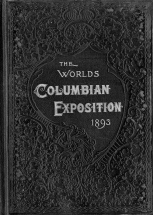It was 103 years ago this month that Bertha Palmer arrived in Sarasota, Florida from her hometown of Chicago. She brought with her a sense of style and luxury to this fledgling coastal town. In addition to her fine furnishings, Parisian clothing, and Monet paintings, she brought a large and complete library. Those books ended up at The John and Mable Ringling Museum of Art Library, where I completed a condition assessment survey and provenance research on this collection.
For some background on Bertha Palmer, take a look at the Wikipedia page about her, or read Hope Black’s Mounted on a Pedestal: Bertha Honoré Palmer, Ishbel Ross’s Silhouette in Diamonds, and Janet Snyder Matthews and Linda Williams Mansperger’s Mrs. Potter Palmer, Legendary Lady of Sarasota.
The Palmer book Collection came to the Ringling Art Library in 1970 through an “anonymous donation.” The donation was likely from someone in the Palmer family, as her descendants were in the area and active in the community. Later in 1970, the books were recorded in the Library’s paper accession logs with their source being “Gift: Mrs. Palmer.” This Collection was housed in the Library stacks, alongside items in the regular collection, until the 1990’s. Linda McKee, the current librarian, segregated the items from the general collection and moved them into a secure, climate-controlled environment. The books were also cataloged and can be found grouped in the Library’s catalog under “Palmer collection.”
Scope of the Collection
There are approximately 134 individual items in the collection, with many titles having multiple volumes. The books cover a variety of subject areas, including decorative arts, visual arts, agriculture, history, architecture, anthropology, painting, and sculpture. A number of the books represent art and design, and it seems as if the books donated were done so with an art library in mind. Other books that the family had, including political, scientific, and literary, were perhaps not donated because there was not a perceived interest in them.
These are some titles which stood out to me:
- The Art of the World, a book compiled by Daniel Burnham, Director of Works for the Columbian Exposition, a limited edition large format 7 volume work highlighting the buildings, sculpture, and art of the Columbian Exposition.
- Italian Villas and their Gardens by Edith Wharton. There are two copies, one belonging to Bertha Palmer, and one belonging to Pauline Kohlsaat, dated Christmas day 1906. Here we have an indication in the shared interest of two Palmer women.
- Les vieux hôtels de Paris. Notices historiques et descriptive by F. Contet. This large format volume measures 45 centimeters and contains 45 numbered, unbound plates. The plates contain images created by modern photographic processes, giving the viewer a more realistic representation than was previously available. The leaves of this unbound volume could have been bound by the purchaser to match their existing library. However, the leaves would have often been left unbound, allowing the viewer to examine the images more closely. This book dates to the period when Bertha Palmer spent much of her time in her Paris apartment at 6 Rue Fabert.
- The hours of Raphael in outline together with the ceiling of the hall where they were originally painted by Mary E Williams. This book reproduces the work by Raphael in the Sala Borgia at the Vatican Palace. The title was part of the Woman’s Building Library at the World’s Columbian Exposition in 1893.
- Art by Auguste Rodin. Bertha Palmer was the only American woman to be sculpted by Rodin. The two first encountered each other when the artist displayed his works at the Columbian Exposition in 1893. The Palmers were patrons of Rodin’s from that time forward. Inside this book was found an early 20th century promotional bookmark from the Scottish Widows Fund.
- The World’s Columbian Exposition, Chicago, 1893 by Trumbull White. This commemorative book contains an introduction written by Bertha Palmer in her role as head of the Board of Lady Managers.
- Our country home; how we transformed a Wisconsin woodland by Frances Kinsley Hutchinson. This book tells the story of a prominent Chicago family who turned a wilderness into a stately home, much as Bertha Palmer would do when she moved to Sarasota, Florida in 1910.
- Modern dwellings in town and country adapted to American wants and climate with a treatise on furniture and decoration by H. Hudson Holly. One of many books that Bertha Palmer owned on the topic of house design, this one was published shortly before she and her husband began construction on their mansion, later known The Castle, on North Lake Shore Drive in Chicago.
- The parks, promenades, & gardens of Paris, described and considered in relation to the wants of our own cities, and the public and private gardens by William Robinson. Bertha Palmer made her first trip abroad shortly after her 1871 marriage to millionaire dry goods merchant Potter Palmer. This book would have served as a guide to the most pristine spots in Paris at that time.
A few books from the collection below:
This post, part one, provided by Jarred Wilson, MLIS candidate at the University of Texas at Austin, and museum library intern in 2012. See Jarred’s wonderful website for more information! www.jarredwilson.com.





Pingback: Bertha Palmer’s Book Collection | Jarred Wilson